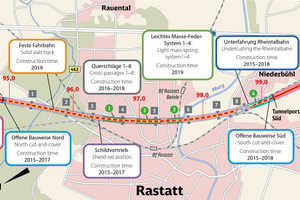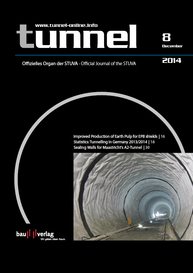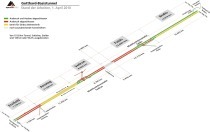Rastatt Tunnel commissioned
The Rheintalbahn (Rhine Valley Railway) is one of Germany’s busiest rail routes. It is extended on to four tracks mainly for the requirements of freight traffic running between the container ports in the north and Switzerland and Italy in the south. This includes the production of a roughly 10 km long twin-track new line to the south of Karlsruhe with the Rastatt Tunnel.
The 4270 m long Rastatt Tunnel passed under the urban area of Rastatt and the Federbach lowland. The tunnel is to be equipped with two single-track bores, linked with a cross-passage every 500 m. It is to be devised for a top speed of 250 km/h. The geological and hydrogeological conditions as well as the shallow overburden of a maximum of 20 m call for special measures such as the utilization of two tunnel boring machines (TBM) for driving from north to south at different times.
Following requests for submissions from all over Europe, the Deutsche Bahn commissioned The Tunnel Rastatt JV, with the technical management in the hands of the Ed. Züblin AG and the Hochtief AG responsible for the commercial side of things, to undertake the roughwork for the tunnel at a cost of 321 million euros. Work commenced in November 2014 with the creation of a site installation yard at Ötigheim and the building of the north groundwater trough, the access to the tunnel’s north portal. Work is due to start on assembling the two TBMs in April 2015 and excavating should begin in October. Roughwork on the tunnel should be completed at the start of 2018. This will be followed by the laying of the solid slab track and furnishing the tunnel. These jobs will probably be open for bids in March 2015 so that trial operations will be able to commence in 2022 following the test phase.⇥G.B.



